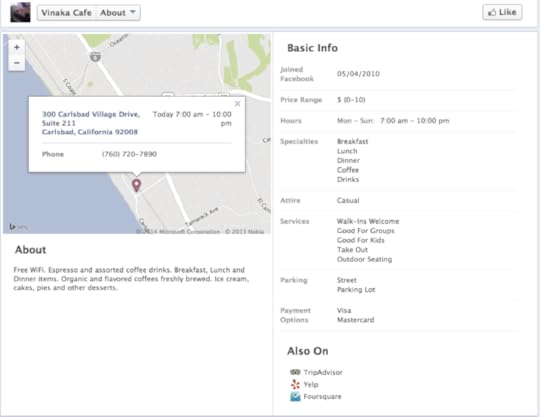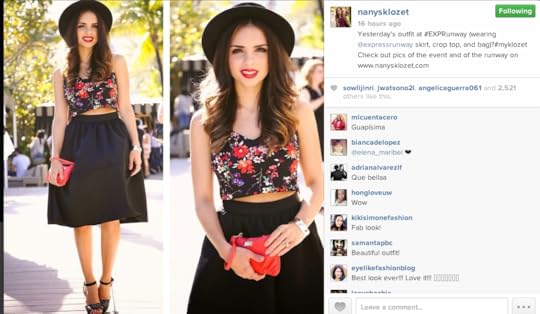Erik Qualman's Blog, page 607
March 27, 2014
How Technology Can Make Moving Easier

Moving home can be one of the most stressful activities for any individual- according to a study, moving is the third most stressful event in life, following death and divorce. However there are many ways that can help ease the stress of moving, including making the most of online resources and smartphone applications. So instead of working yourself up about all of the, what seems like hundreds of things, that are involved in the moving process, take a read and see just how much technology can make moving much easier…
Social Media
Use social media to let your friends and family know that you are moving home and kindly ask if any of them can help you with the move. For example, set up a Facebook group and invite some of your closest friends – write a friendly message and tell them how much you’d appreciate their help. If needs be, tempt them with some incentives – whether it’s some delicious snacks that will keep them going throughout the moving day or a nice bottle of wine to show your appreciation. Even post a photo of the incentives, and add a nice Instagram filter to tempt them and let them know you’re serious.
If you prefer to talk to your friends over phone rather than by Facebook, then Google Hangouts is a great way to ask your friends and family for help. This allows you to video call with a group of people where you can personally give them a detailed plan of what needs doing, when and where.
Although you may feel as though you’re being a burden to your closest family and friends you’ll be surprised at just how many of them would be willing to help you. The more hands you have to help, the quicker, less stressful and not forgetting cheaper the moving process will be.
Twitter is also a great source to use to find out more about the area that you are moving to. Use it as an information resource by, for example, following local businesses in the new area that you are moving to. This will help you to get a good idea of what’s around – whether its days out, restaurants or nightlife. You might also find it a great way to connect with and get to know other local people in your new location.
YouTube
YouTube has hundreds of videos about moving house, whether they are videos on tips of how to pack, how to de clutter, or mistakes not to make. You will find a lot of useful information that you can use to your advantage and will help moving to be as stress free as possible – and what’s even better is it’s free! So forget spending a fortune on expert advice, because it’s more than likely that you will find something just as useful, if not more useful on a YouTube video or elsewhere on the internet.
Forums and Moving company websites
You can find out pretty much anything on the internet these days, so take the time to do your research to find out ways of how you can relieve the stress of moving. For example, read various forums and articles from people that have already moved home. Take their advice and learn from their mistakes so that you don’t do the same.
Furthermore, take a look at the websites of various removal companies – even if you don’t want to choose their services, more often than not they will have some very useful content and advice on their website that you can use for free.
Find out about the area you’re thinking of relocating to
If you are feeling uneasy about the areas that you are thinking of relocating to, there are resources on the internet that you can use to discover information and statistics on aspects such as crime rates, transport and travel, schools and public services and entertainment and nightlife. For example, when you browse properties on Zoopla, they provide you with a detailed account of the area including property details, a map and what’s nearby, a street view map and local info.
Although you can visit the area yourself and get a good idea whether you can see yourself settling there, information on the internet can provide you with the bigger picture and help you to see whether the area will really cater for all your needs for the lifestyle that you want.
Smartphone Apps
There are loads of moving house apps that you can download for your smartphone for free or a very small price. For example, the MoveMe.com app which is free to download, has a moving checklist which helps you manage you’re the moving process. The app can get you instant quotes from different removal companies, mortgages and home insurance. Furthermore, it allows you to compare things like TV, Broadband and utilities costs to ensure that you get the best deal possible in your new home. And once you have moved, it has all the contact information that you need to get in touch with all of your current service providers and update them with your new address.
Furthermore, the House Move app available from Apple ITunes for just £0.69, is essentially just like a moving checklist and allows you to create customised lists for the different stages in the moving process. This is a great way to make sure that you keep on top of all the jobs that you need to do. And even if you don’t manage to complete all of the tasks you had planned to, the app has a feature that allows you to move the tasks to the next list.
Thumbnail Image: http://tinyurl.com/nwrrf8o
[image error]
March 26, 2014
Back to the Basics: When to Use a Facebook Local Business Page vs. Company Page

Facebook doesn’t appear to be going anywhere anytime soon, so it’s important that you’re carving out a space for your company on the social network. However, there are quite a few choices you have when it comes to creating a business page (6 choices to be exact), and it can get a little bit confusing. These choices include:
network. However, there are quite a few choices you have when it comes to creating a business page (6 choices to be exact), and it can get a little bit confusing. These choices include:
Local Business or Places
Company, Organization, or Institution
Brand or Product
Artist, Band, or Public Figure
Entertainment
Cause or Community
The choices are pretty straightforward and it’s clear to most which option they should choose, but the option “company” and “local business” can make you scratch your head in confusion. Can’t you have a company that is also a local business? In fact, how can a company not also be a local business or place?
Although your company might fall into both of these categories, each offers slightly different features. It’s important you think about your goals and what you want to achieve through Facebook in order to determine which Facebook business page is right for you. It might sound simple, but I’ve seen quite a few businesses still getting this wrong, so it’s time to go back to the basics.
Facebook Local Business Page vs. Company Page
You can visit this link to get started with Facebook business pages. You’re then prompted to choose one of the six categories and then follow the directions to create your page, but as discussed above, you first you have to know which type of page you want to create. The differences are explained below:
Facebook Local Business Page
Who Should Use It: This is perfect for those who own a store or a shop that they want people to actually physically go and visit.
How to Use It: The only real information you can enter if you choose this option is your “about” section. There will be a button next to “like” where visitors can leave a review, and check-in is also available. If you choose this option, you will be prompted to choose a category for your business and fill in all basic information such as address and phone number.
Options You Have: You can fill in the “detailed info” section of the page with your website, address, city/town, zip code, opening hours, description, price range, and even parking. This option will also display the number of check-ins next to your “like” fan count. You can go back and make changes at any time.
Example:
Facebook Company Page (called Company, Organization, or Institute)
Who Should Use It: This is great if you have more than one location, so you’re working with different addresses, or if you are more of an online-based company as opposed to trying to get people to come into your store. Franchise companies do well with this type of Facebook page.
How to Use It: You will only have the option to add check-ins to your page after you’ve completed your page (it’s not automatic like with local pages). You do, however, have more options for your info tab including when the company was founded, your address, city, and zip code. This all goes under the “basic info” section. You then have a detailed info section that shows your website, mission, description, products, and awards.
Options You Have: Once again, with this option you also choose from a list of categories and then simply type in your company name (as opposed to your address, phone number, etc. described above). Agree to the Facebook Page Terms and click “get started.”
Example:
The Takeaway
Choosing the right type of page will help you be successful when it comes to Facebook, but you can always make a switch if you change your mind or if your business develops into something different (usually people move from local business pages to company pages).
Have you created a business page on Facebook? Let us know about your experience and what pages have worked for you in the comments below.
The choices are pretty straightforward and it’s clear to most which option they should choose, but the option “company” and “local business” can make you scratch your head in confusion. Can’t you have a company that is also a local business? In fact, how can a company not also be a local business or place?
Although your company might fall into both of these categories, each offers slightly different features. It’s important you think about your goals and what you want to achieve through Facebook in order to determine which Facebook business page is right for you. It might sound simple, but I’ve seen quite a few businesses still getting this wrong, so it’s time to go back to the basics.
Thumbnail Credit: http://tinyurl.com/qbjcqn7
[image error]
Being Outrageous on Social Media: 5 Sites that Do it Best

Through the massive rise of social media over the course of the last decade, viral videos, photos, and articles have become so common, we’ve come to expect them. The very term “viral” has taken on a new meaning. At first, these popular pieces of content were generated by everyday Internet users. It didn’t take long for marketers to take note though, and now it’s become a marketing strategy in itself. It shouldn’t come as a surprise either. Viral videos like Jenna Marbles’ How to Trick People Into Thinking You’re Good Looking video, which was an early entry in this phenomenon, amass millions of views in a very short amount of time. This particular video reached one million views in its first day and sits at 56.6 million views as of this writing.
Jenna’s video was produced and promoted organically, but she’s built quite the empire on YouTube by producing similar videos each week, illustrating just how successful these videos can be. But what’s so great about this type of content anyway, and why should marketers care? Read on to find out why it works, and several sites that have mastered the art of being outrageous on social media.
Creating outrageous content that goes viral with a vengeance involves a certain science. Amid all the attention that outrageous online content has started gathering, certain outlets have become masterminds in the practice. Here are the best of the best sites when it comes to being outrageous on social media.
BuzzFeed
Buzzfeed employs a staff of in-house content creators and works with freelancers to publish content that invokes emotions in viewers. Using its now well-recognized labels (LOL, Win, OMG, Cute, Trashy, Fail, and WTF), it has quickly become a hub of viral media, and a favorite time waster for Internet users everywhere. When it comes to being outrageous online, Buzzfeed has it in the bag.
The fact that people spend hours at a time on Buzzfeed is a testament to its success in sharing outrageous content. It’s not always outrageous content that’s posted on Buzzfeed, either. The site’s most popular post, the 45 most powerful images of 2011, wasn’t original content; rather, it was a mash-up of popular images from the year. For every crazy post that Buzzfeed posts, there’s another news post right behind it. Buzzfeed has become a one stop site of sorts, offering news and entertainment in one fell swoop.
Vice
Headed up by 40 year-old CEO Shane Smith, Vice.com shares some qualities of Buzzfeed, in the sense that it creates and publishes very sharable content, but in an understated and honest way. Vice originated as a magazine by hipsters, for hipsters, but has grown into an unstoppable force of combined Internet and print awesomeness that has solidified itself as one of the most successful and often outrageous publishers ever.
What sets Vice aside from other sites is that it recently launched a news site, complete with fact checkers, to cater to Generation Y’s thirst for news sources that they can relate to. The company website’s “Dos and Don’ts” section is a perfect example of outrageous content that captures attention and encourages social sharing.
Imgur
What was once a simple file sharing site has now morphed into a community in its own right, and may just become Yahoo’s next big acquisition. Outrageous postings on Imgur find their way across the Internet, thus making it a catalyst for content to grow into viral sensations with a lightning quickness.
Imgur is unique in the content sharing realm in that the community that utilizes it tends to be compassionate and empathetic, as opposed to the otherwise cynic nature of the Internet world. Users love Imgur because it gives them a chance to share content that appeals to them, whether it’s outrageous or heartfelt.
Quite often what makes Imgur posts so funny is the user-submitted reactions in the comments. Take this post, for instance. The photo is mildly funny, but when you read the top comment, it’s full-on chuckle worthy. It’s clever, and surely generated thousands of shares across the Internet.
Mashable
Pete Cashmore founded Mashable when he was 19 years old, and has since nurtured it into a force to be reckoned within the world of content creation. The site serves as a platform for news and entertainment content that focuses on topics such as technology, beauty, business, economics, and countless others. It competes directly with outlets such as Vice and Buzzfeed, but carves a name for itself and stands out in the crowd, thanks to its distinctly news-oriented approach. The primary factor that sets Mashable apart from the rest is the fact that its news articles are well-researched and in-depth.
But right next to those legitimate articles are hilariously outrageous bits of content that viewers can’t help but chuckle at. This piece is a compilation of reactions to Justin Beiber’s recent arrest. At the time of this writing, it’s been shared 9,900 times. There’s no doubting this outrageous approach works on social media for Mashable.
Funny or Die
Funny or Die produces content catered around topics such as politics, hollywood, television, movies, and news. It makes people laugh using many forms of media, including videos, articles, and photos based around topics that are timely and relevant to pop culture. Check it out to give yourself a chuckle.
Recently a sensational video featuring what seemed to be a dream come true for Back to the Future fans: a hoverboard. The video included big names the likes of Christopher Lloyd himself, Tony Hawk, Moby, and Terrell Owens, and other big names and fooled a lot of people into thinking hoverboards were really happening.
Even the follow-up video from Funny or Die, in which Christopher Lloyd hilariously owned up to creating it, and satirically apologizing for duping so many people spread far and wide.
As you can see, being outrageous works on social media. It’s the most outrageous content that users are most likely to share. What’s the most outrageous thing you’ve seen shared on social media lately?
Thumbnail Image: http://tinyurl.com/qcont73
[image error]
March Madness Going More Social


Nearly 140 million people watch March Madness, according to a PBS report.
For one of the most exciting sports tournaments in the world, it is no surprise that social media has taken interest. As a result, you can easily find all types of networks buzzing about the results, news, and predictions of the games.
Follow along as we take a look at how social media has devoted so much time to a sports event that is fittingly-named.
From the Schools to the Sports Outlets
No longer are news stories and updates across the web given by sports sources. All of this is much more integrated.
Take a look at a major social network such as Facebook or Twitter, and you’ll see all types of talk about March Madness from more than just the news sources. The usual suspects are the basic news source, sports-specific sources, and all of the niche sports sources, where the latter is found with blogs.
But now the schools are taking part.
A trending topic prior to the start of this year’s March Madness, the Wichita State Twitter account, has been all in on the festivities following the school receiving a number one seed in the tournament (The Shockers lost to Kentucky on March 23). Several other schools that made in on workers’ brackets across the nation joined in on the action in anticipation for the tournament.
Take a look at their media – and you’ll find photos of basketball shoes, excited fans, cool jerseys and everything else surrounding the game of basketball. During the month of March, college basketball reigns for many teams and fans.
It’s All in Real Time
Keep your Twitter open the next time you watch a March Madness game. There is little doubt that a trending topic will be related to the tournament; this is the beauty of March Madness and social media.
While you may be watching an exciting game alone, you don’t have to – you can connect to others around the world that ultimately end up skipping work. For even a mildly exciting game, it’s tough to keep up with the comments people are making as they watch the game.
This is due to the prominence of a second screen in sports and television in general.
Many people are so close to their smartphone or tablet that they can’t help but comment on games as they happen. This has led to such an uptick in social media messages during March Madness and other sporting events. It has also led to popular sports apps that integrate messages and predictions that are game-specific.
Social media and March Madness are quickly becoming inseparable.
Take a look the next time you see a game in March to experience the madness.
Photo credit: anchormd.com
Slider Photo: http://tinyurl.com/l48pmln
Thumbnail Photo: http://tinyurl.com/q3lg2cc
[image error]
March 25, 2014
Top 5 Mistakes to Avoid When Creating Viral Infographics

By Justin Beegel, CEO and Founder of Infographic World and Author of “Infographics for Dummies” Set to Launch in May
According to Google, searches for infographics have increased 800% in the last two years. As more companies than ever use infographics as a tool to grow their brands, the elusive question of how to go viral remains.
The fact is, even the savviest experts can’t always predict what will catch fire. That is why it is critical to avoid common mistakes that have proven to immediately turn off media and consumers alike.
At Infographic World, we have done campaigns for more than 30 Fortune 500 companies and I have identified the top five mistakes companies make when creating infographic campaigns.
Top Five Mistakes to Avoid:
1. Make it About a Topic, Not the Company: The number one turn off is having too strong a company presence on the infographic. It is only natural for brands that pay money to create a campaign to want as much exposure as possible. However, they must ask themselves whether you would rather have 10 logos on a graphic that only lives on their homepage, or one well-placed logo on an impactful graphic that is being shared around the world?
2. Playing it Too Safe: As social media gaffes steal headlines and damage careers, companies are very careful about what they put out, and they absolutely should be. At the same time, when constructing an infographic you have the opportunity to walk the fine line on controversial issues. Smart and controlled depictions of issues will spur debate and kick start a viral campaign. Make sure to consult with the experts before releasing anything that could be damaging.
3. Overcrowding: Cramming too many facts and angles into your infographic is a recipe for disaster. The beauty of infographics is that they take complex subjects and visually tell the story in a succinct way. In the new 140 character world, we must keep it short or loss the reader. Keep is simple.
4. Being Inaccurate and Outdated: If even one statistic is wrong or outdated, media outlets and readers alike will dismiss the graphic and create a bad taste about the brand in general. Getting it right is crucial. Citing stats from 2009 when we are heading towards 2014 will make visitors close out, not forward.
5. Poor Planning: As Thanksgiving approaches, a light bulb may go off about a great infographic that ties into turkey day. Great, right!? In theory, but the problem is that infographics will require sound research, creativity, editing and approvals. Scrambling to create something last minute will not give you appropriate lead time to promote it and let it go viral. Nobody wants to run the Thanksgiving graphic after the last bite of turkey. It is crucial to plan ahead and allow the infographic time to pick up speed.
By identifying and mitigating these five common faux pas, you will be closer to producing a flawlessly produced infographic that has the opportunity to go viral and create a huge splash for your business.
# # #
About Infographic World:
Infographic World is a leading information graphics company based in New York City. The company, which launched in 2009, made $1.5 million in revenue in 2013 and is experiencing triple digit annual revenue growth. Infographic World’s long list of world-class clients includes 30 Fortune 500 companies who represent $1.88 trillion in revenue, such as Google, Intel, ESPN, P&G, Discovery, McGraw Hill, Pepsi, Intuit, and McCann. The company has a proven track record of creating graphics that go viral – reaching hundreds of thousands of websites as well as creating highly engaging visual communications for brands across the world. For more information please visit www.infographicworld.com.
About Justin Beegel:
Justin is the 28 year old Founder of Infographic World, a leading information graphics company based in New York City. The company, which launched in 2009, is projected to make $1.75 million in revenue in 2013 and is experiencing triple digit annual revenue growth. Justin attended Binghamton University where he earned his undergraduate degree and his MBA in entrepreneurship and marketing. Before starting Infographic World, he was the Social Media Marketing Manager for Hachette Filipacchi Media, which was the publisher for Elle, Car and Driver, and Woman’s Day, among others. He was charged with driving traffic to their websites and displayed a unique ability for creating content that went viral and increased traffic.
Justin is also the author of Infographics for Dummies, a Wiley publication, set to be launched in March 2014.
Thumbnail Image: http://tinyurl.com/nmo5rym
[image error]
How to Make the Most of Tumblr for your Brand

When devising your marketing strategy, Facebook, Twitter & LinkedIn have long been the first port of call. There may be a missing ingredient, however, another important platform to give your content that extra push.
With over 132 million blogs on the site alone, Tumblr’s potential reach is huge. According to Quantcast, the site received over 5.5 billion pageviews in May 2013 alone. With user numbers and popularity on the rise, it’s a perfect marketing tool for businesses that are trying to extend their reach and raise brand awareness.
1.) Build a Brand Persona
Tumblr is a breeding ground for all things viral. Because of this, building a relatable brand persona and identity can be easily done. Decide on a brand identity early on in your strategy and build your page around that. Do you want to be funny? Or maybe be helpful? Having a niche could give your site the edge.
Food company Whole Foods are a great example of a brand who did just this. They created an online magazine, “Dark Rye” that features short-form content that reinforce a health-conscious living style. Everything from tips to cook corn, to quotes on community and creativity. Whole Foods manage to avoid a hard sell whilst still building a definite persona centred around their brands values.
2.) Be Helpful
Tumblr provides a great way to build recognition as an expert within your field. Be helpful, offer advice and tutorials and develop your niche. Dynamic Auto Mobile Mechanic is a great example of a company that you would not think would be using Tumblr. However they give their audience instructions on topics such as how to upgrade their cars and how to get better gas mileage.
3.) Be Visual
Probably the first thing you’ll notice about Tumblr is how image-focused it is. In fact, half the content on the site are pictures and uploading your own visual content is actively encouraged. Again, refer back to your desired persona (step one) and have a think what kind of images fit that. For example, posting “behind the scenes” photos of upcoming products or highlighting a newly released product are a great way to get your followers excited and allow them to share your content with their network.
A brand who do great things with thier tumblr are Net-a-Porter. On their Tumblr page, they publish outtakes from their photo spreads in The Edit, giving a feeling of exclusivity to their followers.
4.) Incorporate Video
If your brand use video, then Tumblr should definitely be in your marketing strategy. In Adobe’s Q4 2013 Video Benchmark report, it was revealed that social network Tumblr is responsible for referring more average video starts than YouTube, Twitter and Reddit. Equally, Tumblr is producing nearly identical video view rates as Facebook, with over 1/3rd of referred visits producing a video start. Even more impressive is that 56% of the visits referred from Tumblr resulted in a view.
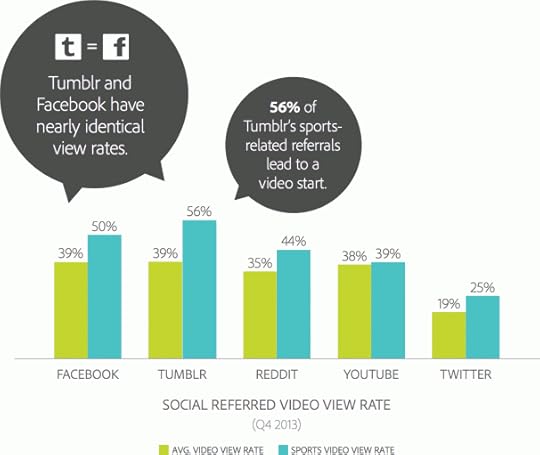
5.) Interact, Share & Be Social
Above all, Tumblr is still, primarily, a social media state. Follow and interact with lots of relevant Tumblr pages and begin to post your own content.
Follower counts aren’t displayed on Tumblr and you can follow any number of people or brands immediately without appearing spammy. Once you gain some exposure and establish a positive reputation, your follower count will increase organically. Reblog, comment on or like posts from the blogs you follow & share relevant posts that fit in with your business. This will help to build your audience, acquire new followers and enhance your brand image by bringing exposure to your company profile.
Madeleine Hammond is a marketing executive at Skeleton Productions – one of the UK’s leading video production companies.
Thumbnail Image: http://tinyurl.com/osukrn4
[image error]
March 24, 2014
What Makes a Personal Fundraising Page Effective?

No one really likes to ask for money, but sometimes you have to; your organization depends on you. Whether you are fundraising as a volunteer or it’s your career, you know you have to hit as many venues as you can reach to get the word out, and bring it the most funds.
What about a personal fundraising page and using social media to help visitors find it? This is a great way to reach out and let those in your social media circles know what you’re doing.
Why use a personal fundraising page?
If you are fundraising, for instance, running a 10k to fundraise for a non-profit you are involved with, you want to make it as easy as possible for your contributors to find where and how to make those contributions.
A personal fundraising page is the perfect way to do this. It’s easy to do send in your contribution electronically and not worry about getting a check in the mail.
Not only can people make contributions directly to the page, but they can also write a message, personal or anonymous, and see your story.
The story of fundraising is always important; it’s what makes the impact.
Perhaps you are running for mental health awareness. That in and of itself is a great thing, but when you are add your personal story – maybe a family member battles with a mental disorder or you yourself do – your friends will be more inclined to contribute, as they care about you and want to support a personal cause. The personal fundraising page is the perfect venue to tell your story.
If you are wondering what makes a personal fundraising page effective, your story is one of the biggies.
You can also keep track of your contributions as well as team members’ (if you have a team) contributions easily and consistently on a personal fundraising page.
Your page will keep a running tally and let you know in real time what your current contributions are, who is making them and how you stand in relation to your goal.
How can social media help?
Social media can play a giant role in your personal fundraising.
Whatever social media platforms you use, be it Facebook, Instagram, Twitter, even Pinterest or YouTube, link it to your personal fundraising page.
Your friends can share it as well, so their followers and friends can see what’s going on there. You can tweet when you’re close to your goal or send an update when you feel you need to get that extra push in.
Social media is also a great place to thank your contributors and supporters.
The great thing is, social media can play a huge part in getting awareness out about your cause while fundraising.
Each time you tweet a thank you or Facebook an update, you are sending important awareness information about your cause to all your friends and followers, and that’s part of the ultimate goal of any type of cause.
Sure, use personal emails and even an actual letter to send to your friends and colleagues about your fundraising effort. But don’t overlook social media and your personal fundraising page.
The convenience, personalization and sharing options of that page are all what make it an integral and successful part of fundraising.
Photo credit: news-quality.com
Thumbnail Image Credit: ”Stock Photo: Green Piggy Bank With Dollars Sticking Out – Isolated On White Background” on Shutterstock: http://tinyurl.com/p3jl9pm
[image error]
March 21, 2014
New Search Engine Features Beef Up Restaurant Results

Google and Yahoo! are once again competing for local and mobile market-share with new features that promote additional restaurant information in search results. Because of the massive demand for restaurant information from local and mobile searchers, search engines are looking for ways to provide more relevant information to users. Taking advantage of these new display options should be an integral part of restaurant marketers’ local SEO strategies.
Restaurants are the most searched for local topic and the most popular industry to search for on mobile devices, with more than 80 percent of searchers looking for places to eat either on a mobile web browser or mobile app. In order to drive visibility through search results and drive sales, local and mobile optimization is a must for any restaurant.
Yahoo! Partners with Yelp
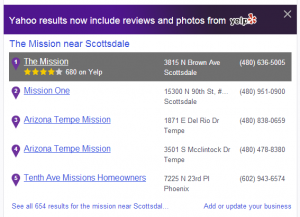 Yahoo! and Yelp’s new partnership puts Yelp reviews, pictures and other information at the forefront when people search for restaurants. The Yelp reviews being given prominence have overtaken reviews written on Yahoo!’s local listings.
Yahoo! and Yelp’s new partnership puts Yelp reviews, pictures and other information at the forefront when people search for restaurants. The Yelp reviews being given prominence have overtaken reviews written on Yahoo!’s local listings.
This new feature is just the latest reason for restaurants to claim their Yelp listing and upload complete information, including pictures. Local searchers are heavily influenced by the opinions expressed on websites like Yelp. Dimensional Research reports that 90 percent of consumers say that positive online reviews had a direct impact on their buying decision. The same study found that 86 percent of people were affected by negative reviews.
 Some other features that Yahoo! searchers will enjoy are the easy-to-find links to directions, reservations and menus — three of the most searched for topics when it comes to local and mobile searches for restaurants. By putting this information front and center, searchers can make purchasing decisions easier and faster than before. Restaurants that forgo uploading this information to Yelp will be at a disadvantage in the local and mobile search marketplace because consumers will be attracted to businesses that provide the information they’re looking for in an easy to see and use way.
Some other features that Yahoo! searchers will enjoy are the easy-to-find links to directions, reservations and menus — three of the most searched for topics when it comes to local and mobile searches for restaurants. By putting this information front and center, searchers can make purchasing decisions easier and faster than before. Restaurants that forgo uploading this information to Yelp will be at a disadvantage in the local and mobile search marketplace because consumers will be attracted to businesses that provide the information they’re looking for in an easy to see and use way.
Google Ad ding Menus to Search Results
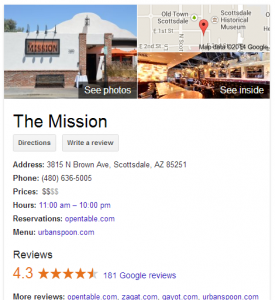
Google has put restaurant menus at the top of search results without forcing searchers to make any additional clicks. Google even divides the menu into different categories like starters, entrees and desserts for consumers. Google has not said where it gets the menu information from, except that it comes from a 3rd party site. Therefore, restaurants should make sure to upload menu information in a variety of places including OpenTable, Yelp, UrbanSpoon and TripAdvisor.
Underneath the menu is a link to more information about the restaurant. Clicking that brings searchers to a different page that includes knowledge graph information about the restaurant, including Google+ reviews, links to Yelp and Urbanspoon, directions, contact information, and hours of operation.
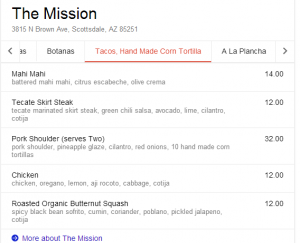 While adding a menu may or may not increase local search engine rankings, having this information available to searchers makes restaurants more attractive to eaters. With each page searchers have to click through to find menu and pricing information, they’re more like to leave and look for a different restaurant. Because the menu display is also directly linked to Knowledge Graph information — which includes contact information, reviews and directions — it gives Google access to menu information and provides searchers one more way to find more details about the restaurant.
While adding a menu may or may not increase local search engine rankings, having this information available to searchers makes restaurants more attractive to eaters. With each page searchers have to click through to find menu and pricing information, they’re more like to leave and look for a different restaurant. Because the menu display is also directly linked to Knowledge Graph information — which includes contact information, reviews and directions — it gives Google access to menu information and provides searchers one more way to find more details about the restaurant.
Conclusion
Local and mobile consumers actively search out review and menu information before making a purchasing decision. Restaurants that make this information available to search engines like Yahoo! and Google to prominently display to searchers will be at an advantage compared to local competitors. For restaurants, dominating local and mobile search is about proving the information searchers want as easily and quickly as possible. Google and Yahoo! are helping restaurants do that, but restaurants need to be proactive in disseminating information, making it available to search engines, and eventually local searchers.
Without a local search strategy, even the best business models will not reach their maximum potential. ZOG Digital’s search and social marketing strategies increase online brand visibility and drives sales. Contact ZOG Digital to start an audit of your digital marketing efforts today.
[image error]
March 20, 2014
How to: Monetize your Brand on Instagram
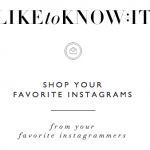
Instagram is a fun, visual, and engaging channel for brands, influencers, and consumers. People love posting photos of their meals, outfits, pets, vacations, so on and so forth. Brands can take advantage of Instagram by focusing on people’s passion points and what evokes emotion from them each day. For example fashion brands can easily upload photos of their upcoming lines, models wearing their latest and greatest, influencers wearing their exclusive garb on their vacations, etc.
So you get followers, got it. You get likes and comments. Awesome. But what about selling your products? You can do that too – really. Instagram has become another avenue for referral traffic to your brand site, consumer products, and direct purchase.
3 ways to monetize your brand through Instagram:
Keep it Simple: Sometimes it’s easier just to provide a link to your blog and/or product link for consumers to find the item they want with one action. Why make it harder through re-directing a few different times. Tip – you cannot actually “click” on the link. Someone will have to re-enter the link on their browser. But for now, it will do. Instagram, are you listening?
Brand Example: Nordstrom – They do a great job of giving you the item reference # so you can find the exact item on their site with less searching. Great way to get around the current roadblock.
Use Influencers: There is a plethora of instagram influencers who are probably already posting your products or like-minded photos. For example bloggers like Daniela Ramirez or better known as @nanysklozet on Instagram is constantly posting about what she wears, how she wears it, and what’s in her “klozet.” It gives her followers ideas on what brands are great to purchase from and why it rocks. She will post links to the items on her blog, so she’s creating referral traffic for the brands not only from her instagram account through branded hashtags, but also through her style blog. Double the score.
There’s an App for That: The tough thing as mentioned above, is when you provide a link, no one can click through the app currently. However there are workarounds such as Like To Know It which allows influencers to post a direct link for purchase of the item they’re promoting. Additionally, it allows consumers to find that specific item without hunting, and/or similar products to what they saw on the app. For example, perhaps that pair of shoes was a tad too pricey, maybe there’s a more attainable pair you can purchase with the same look. Why is an app like this important for both influencers and brands? Because it’s a direct path to purchase for consumers who want what the influencers have. They want it right then and there. So let them have it at their fingertips.
Infuencer Example: Aimee Song (@Songofstyle) uses Like to Know it!
Alternatively, if Like to Know It is too complicated with Reward Style (invite-only) registration, services like Soldsie and Chirpify allow for quick and instant transactions through the comments feed (utilizing action words and hashtags).
Bonus Tip – If you only post the photo and no way for them to find out about how to get it, they’ll lose interest in the brand (especially if the brand doesn’t respond). Provide a relevant brand hashtag, a link to the item they are coveting, and/or tease them until it’s available. Sneak peeks are a great way to entice a frenzy at launch. Just look at SJP Collection as an example with their exclusive launch through Nordstrom.
Questions on how to use instagram for your brand? Reach out in the comments below!
Photo Creds:
http://instagram.com/nordstrom
http://instagram.com/nanysklozet
http://instagram.com/songofstyle
http://instagram.com/sjpcollection
http://liketoknow.it/
[image error]
The Role of Social Media in the Cosmetic Industry

According to the Adobe 2013 Mobile Consumer Survey, accessing social media is the number one mobile activity today.
With this in mind brands and companies need to become savvy with this technology to ensure they can connect on a personal level with users. Social media has revolutionised the way that the cosmetic industry connects and communicates with customers. The customers are there, brands just need to be present and engage.
There are many different social platforms such as Facebook, Twitter, Google+, LinkedIn, Pinterest and Instagram which allow brands to build trust and give a sense of community online, which leads to loyal followers and brand advocates.
High customer involvement and engagement
Social media is a two-way communication between the target audience and the cosmetic provider. The cosmetic companies are able to generate customer feedback via different online presences. Additionally, they are able to use social media to better target and approach their own customers and listen to different voices from them.
Cosmetic Industry brands need to be really honest, which can be at the root of some of the fear for the industry; Shami from Transform Medical Group,
“We understand that social media isn’t just used to highlight good news, that you have to be honest and if your consumers raise concern then you need to be able to answer their queries truthfully – it’s a two way conversation after all. We saw many of our competitors especially throughout the PIP scandal remove their social platforms avoiding association with the issue.”
High Brand Loyalty
Social media is great for storytelling and allows for companies to maintain and build up their brand to build online communities. Platforms such as Twitter, Pinterest and Instagram are commonly used to present new products, display before & after images and gain brand loyalty from customers. Social media offers cost-effective opportunities for the industry to build their brands. “with at least half of Twitter and Facebook users said they are more likely to talk about, recommend or purchase a company’s products after they begun following them on social media,” according to eMarketer 2011.
Create Sales
Social media is transforming the way that cosmetic companies generate their sales, through word-of-mouth. Many users who haven’t had previous experience with a brand will endeavour to look at their social platforms to gauge other user’s reviews and comments.
[image error]

